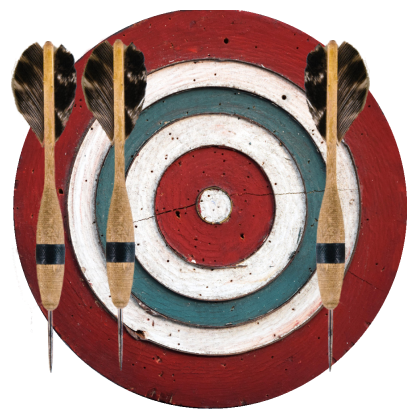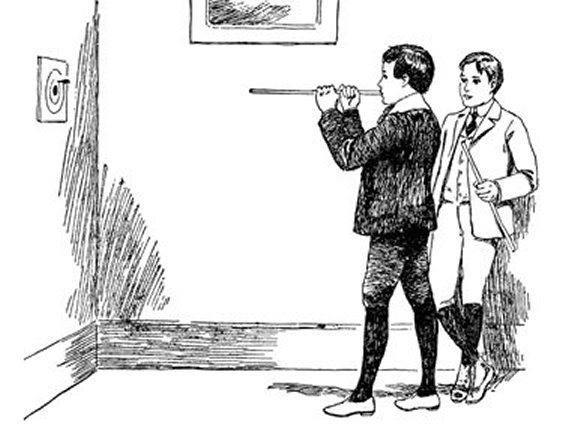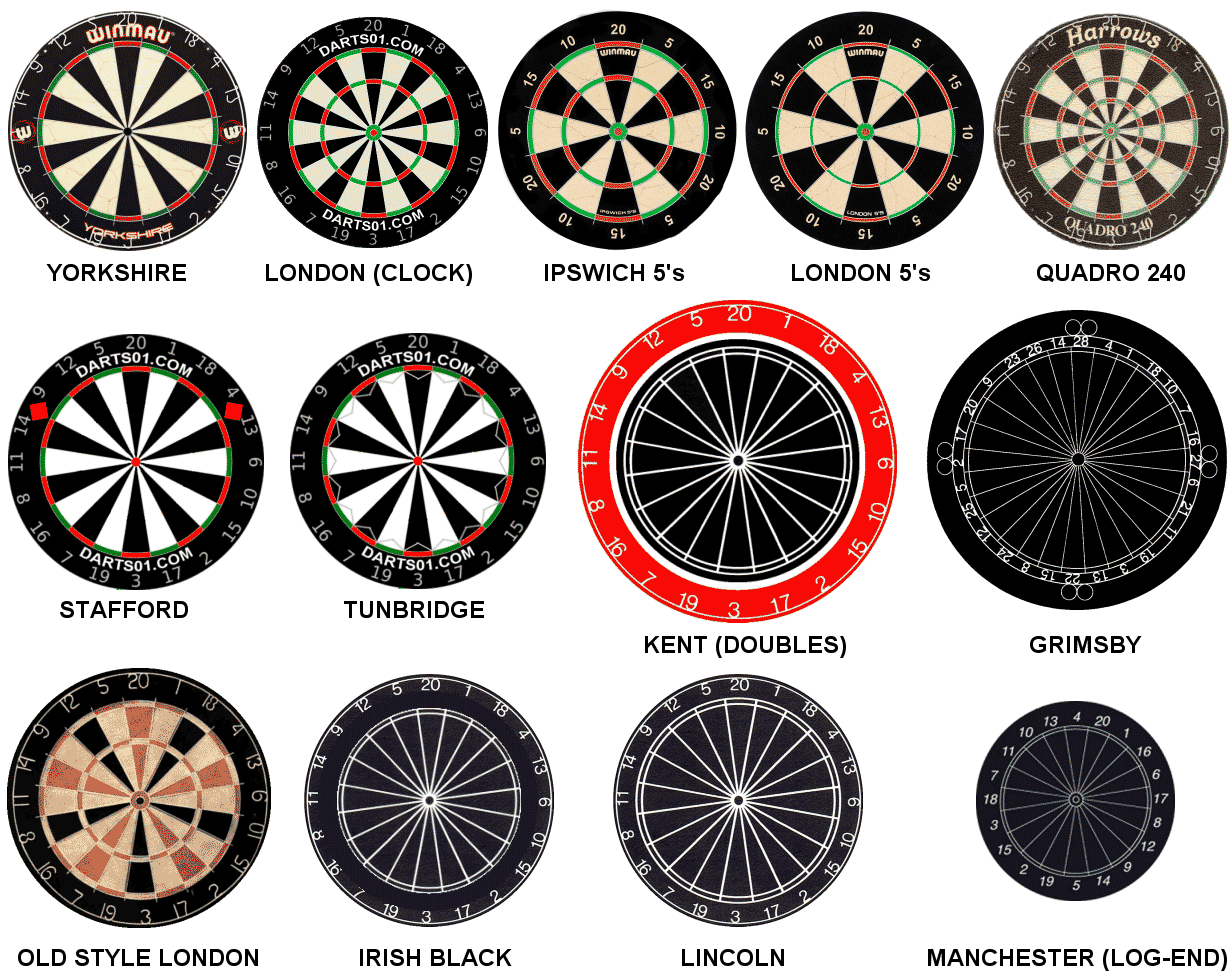A Brief History of Darts!
A brief history of the modern game of darts
The brief history of darts!

Although references are made darts first being used from the medieval time when Bowman would use a shorted arrow to use as a throwing arrow into a wooden target the modern game stems from France.
Darts, known in France as 'Flechettes' (meaning 'small arrow') consisted of a short dart thrown into a target with concentric rings. The original darts were made from wood. They had a metal point and the flights were made from bird feathers mainly turkey feathers.
There is good evidence to support the English game of darts originated at the fairground. His research says that darts is not unique in this as other pub games such as Skittles and Aunt Sally also have historic links to the old English fairs (Fayres). It seems these games were popular and as the fair left town, some of the games remained or a version of the games remained.
The fairground style dartboard was designed to make the game look easy than it actually was to win a prize, so the likelihood that the segment section of the dartboard stem from these early fairground boards mid-19th century.
Dart and Target (Puff Darts)
Although no resemblance to the throwing dart game we see today, Puff and Dart was another forerunner of a target sport involving a dart propelled via a blowpipe. This was not only a parlour game (house game) but also mentioned in ’Lawful Games on Licenced Premises’, 1904. The target was a board would have been concentric circles and not the segmented target area we are more used to seeing today.
The board would have been made from softwood and painted with three or four different coloured circles with a bullseye in the centre.

England Pub Darts
England’s pubs took to darts in a big way and dartboards and games were devised. Each region would have their own board design, however, most had some form of segmented circle target area. In to increase difficulty, additional scoring areas were added notably the double ring which would normally be situated on the perimeter of the circle ring. However, on the Tunbridge dartboard this area scored triple and a different area was used to score doubles! (See regional dartboards section)
The treble ring as we see it today on a modern dartboard was introduced 1920’s, however, it wasn’t an instant success. The dartboard was known as the ‘London’ or ‘Clock’ dartboard. Strange to call it a clock dartboard when it had twenty segmented areas. The more common dartboard at the time would have been the Yorkshire dartboard. This dartboard consists of twenty scoring areas, a single bullseye and a doubles ring. Why the London dartboard was an instant success is unclear, however, some may have thought a fluky dart could score a lot more than the opponent may have liked but today this board has become standard.
So, a single, double and treble! Why not have a quad scoring area? Well, this has already been done a maximum of a three-dart score of 240! Meaning a 7 dart 501 could be achieved. The dart and dartboard manufacturer Harrow’s introduced such a dartboard. It was known as the Quad 240, sadly no longer made. It did, however, gain some prestige with TV tournaments and some can still be viewed on YouTube.
(Pictures show an old fairground dartboard)

![]()
Some of the regional dartboards both past and present
|
|
Please do not copy or reproduce images or text on this website. If you like what you see please add a hyper link to the page. Thank you.
Read more about regional dartboards under the Dartboard section of this website.
![]()
Dartboard numbers?
A commonly asked question is why are the numbers on a dartboard arranged as they are and who first thought the number sequence up?
I have a page dedicated to this question because it has been a debate for many years. In short two main people feature Brian Gamlin and Thomas William Buckle. Many references give the accreditation to Brian Gamlin who supposedly was a carpenter who lived in Bury, Lancashire in the 19th century. I have lived in this area for over 25 years and done a bit of digging and cannot find any reference or censors naming this man. I even had the local newspaper involved at one point to try and find descendants to no avail. The man cannot be traced.
Thomas William Buckle on the other hand was a wire maker and dartboard maker. He certainly made the Yorkshire dartboard and with some claims from his son he is the more likely candidate for this accolade.
Read more about the Dartboard numbers and if they are set at the optimum positions here.
Picture Thomas William Buckle - Dr Patrick Chaplin Darts Archive - Used with permission

Tomas William Buckle
There are also separate sections on regional dartboards and the games that are played on them.
If you want to learn a bit more about darts and flights then explore the website further and here you will find the development of darts and dart flights from feathers, paper, plastic through to other materials such as nylon and modern plastics.
An additional section is also available on the dartboard development from wooden, to sisal and the soft-tip darts.
Would you like to learn more about Darts History?
Although I have a brief history of the sport within the history section of the Darts501.com website, if you want to read more about the past 100 plus years and players from the past then take a look at Dr Patrick Chaplin's website where he shares lots of information. However, his books always cover more so I suggest you subscribe to his FREE monthly Dr. Darts’ Newsletterand I am sure you will be kept informed of his latest and potentially last book on the sport.
Dr Patrick Chaplin (Darts Historian)
Dart fans will also be pleased to know that Darts Historian Dr Patrick Chaplin is writing a new book with the working title The Sport of Pints – The People’s History of Darts. It will cover the history of darts in the Second World War and the post-war years, a period that, to date, has hardly been written about: a period about which very little (if anything) is currently available anywhere.
Where this new book will stop is, as yet, unknown.
Patrick has informed subscribers to his ‘Dr Darts Newsletter’ (DDN) that the new book will also cover dart stars of the past such as Jim Pike and Joe Hitchcock whose life stories have never, until now, been properly recorded.
The book was in the planning stages a few years ago and a publisher secured but Patrick had to abandon the project in 2017 due to what became a series of personal tragedies.
This book has been long-awaited by many dart fans interested in the history of the sport, and it follows on from Patrick academic work Darts in England, 1900-39, A social history, the book based on his PhD, which was published in 2009.
Patrick is also Chairman of the Pub History Society and has written two local history books about Langford (Essex) the village in which he was brought up.
Here is a list of Patrick’s past publications which also includes dart players autobiographies and joint ventures with dart stars:
Sole author:
Darts in England, 1900-1939 – A social history (Manchester: Manchester University Press, 2009. Paperback edition 2012)
The Official Bar Guide to Darts (New York: Puzzlewright Press, 2010) )
180! – Fascinating Darts Facts (Stroud: The History Press, 2012) )
Darts. Skills. Tactics. Techniques. (Ramsbury: The Crowood Press, 2015) )
With John Lowe:
John Lowe – Old Stoneface: The Autobiography of Britain’s Greatest Darts Player (London: John Blake, 2005. Revised paperback edition 2009) )
The Art of Darts – A Masterclass with 3-time World Darts Champion (London: Hodder & Stoughton, 2009) )
With Trina Gulliver:
Golden Girl – The Autobiography of the Greatest Ever Ladies Darts Player (London: John Blake, 2008) )
With Bobby George:
Scoring for Show, Doubles for Dough – Bobby George’s Darts Lingo (Clacton-on-Sea: Apex Publishing Ltd., 2011) )
......
Acknowledgements | Privacy, Cookies & Terms of Use | FAQ



